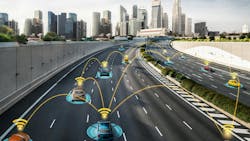The Department of Transportation recently released its plan to deploy vehicle-to-everything technology, or V2X, across the nation to reduce deaths and injuries on U.S. roadways. The news came late last week at a press conference in Washington, D.C.
“Last year, we tragically lost 40,990 lives on our roadways,” Dr. Robert C. Hampshire, principal deputy assistant secretary for research and technology and chief scientist, stated. “In response to that, our administration has developed our national roadway safety strategy that really outlines our approach to addressing this challenge.”
See also: NHTSA estimates fatalities continue to decline in 2024
Harnessing V2X to improve U.S. roadways
V2X technology allows vehicles to communicate with each other, other road users, roadside infrastructure, and more, Hampshire said. The goal of using this technology is to “enable a more safe, secure, and efficient transportation system,” the DOT stated in a press release.
The V2X technology deployment plan isn’t for the sake of testing the technology, said Shailen Bhatt, administrator of the Federal Highway Administration.
“This is proven technology that works—we know it works,” Bhatt said. “We know it works in the field. We know that there are deployments out there right now, today, across the nation, that are utilizing V2X technology.”
V2X technology has been in development for decades, according to John Bozzella, president and CEO of Alliance for Automotive Innovation, but widespread adoption of the technology has been “hampered by regulatory uncertainty,” he said during the press conference. Part of that uncertainty has been a lack of buy-in from the DOT.
In 2022, the Alliance outlined 10 specific policies that were needed to deploy V2X technology, and key among them was for the DOT to develop an implementation roadmap, Bozzella explained.
“And here we are,” he said during the press conference.
See also: How using a smart tablet as an ELD improves driver efficiency and safety
A unifying roadmap to V2X implementation
The DOT released its proposed plan last October. This final plan “will contribute to the Safe System Approach adopted by the USDOT’s National Roadway Safety Strategy, a comprehensive approach launched in January 2022 to address the crisis of roadway deaths,” the DOT’s press release states.
While this plan acts as a “roadmap” to implementing V2X technology, it’s also a unifier, connecting different sectors and industries.
“Our community has been working on this technology for years, from the researchers developing the technology to the public agencies laying plans on how they're going to use the technology, to the automakers preparing to deploy this technology on their vehicles,” Laura Chase, CEO of ITS America, said. “What this plan does is coordinate all of those efforts and all of those key stakeholders and sets milestones for each of the stakeholders and actualizes a path forward to nationwide skilled deployment.”
Further, the plan partners both the public and private sectors with state DOTs and cities and even academia, Bhatt said.
Implementing the plan would begin once the Federal Communications Commission adopts the final rules for the 5.9 gigahertz spectrum.
Of the 5.9 GHz band, 30 megahertz were set aside for automobile safety technology, according to an FCC press release, but “little progress” has been made toward its development. On July 17, a vote was announced to determine the final rules that would “allow in-vehicle and roadside units to operate cellular-vehicle-to-everything technology in the 5.9 GHz spectrum dedicated to Intelligent Transportation Systems.”
“We look forward to the FCC adopting the final rules for the 5.9 gigahertz spectrum so that we can deploy [the plan] imminently,” Chase said during the press conference.
Nationwide implementation of V2X
The DOT plans to have 20% of its system deployed by 2028 with the collaboration of automotive partners, private sector partners, cycling partners, and vulnerable road users, Bhatt said.
Grants and funds from the Infrastructure Law will enable the rollout of V2X technology nationwide. In some areas, such as Utah, Texas, Colorado, Wyoming, and other states, grant money from the Federal Highway Administration totaling around $60 million has already been awarded toward implementing this technology.
“To equip the infrastructure that is out there [with V2X technology], it is going to require tens of millions of dollars of investment,” Bhatt said. “But I would also say that we spend tens of billions of dollars every year on our transportation system. The great thing about the Bipartisan Infrastructure Law is that it has provided a generational investment in transportation and one of the great things about the technology ... is it is now eligible for federal funding so that state DOTs can use this as one of their safety tools.”
About the Author
Jade Brasher
Senior Editor Jade Brasher has covered vocational trucking and fleets since 2018. A graduate of The University of Alabama with a degree in journalism, Jade enjoys telling stories about the people behind the wheel and the intricate processes of the ever-evolving trucking industry.

